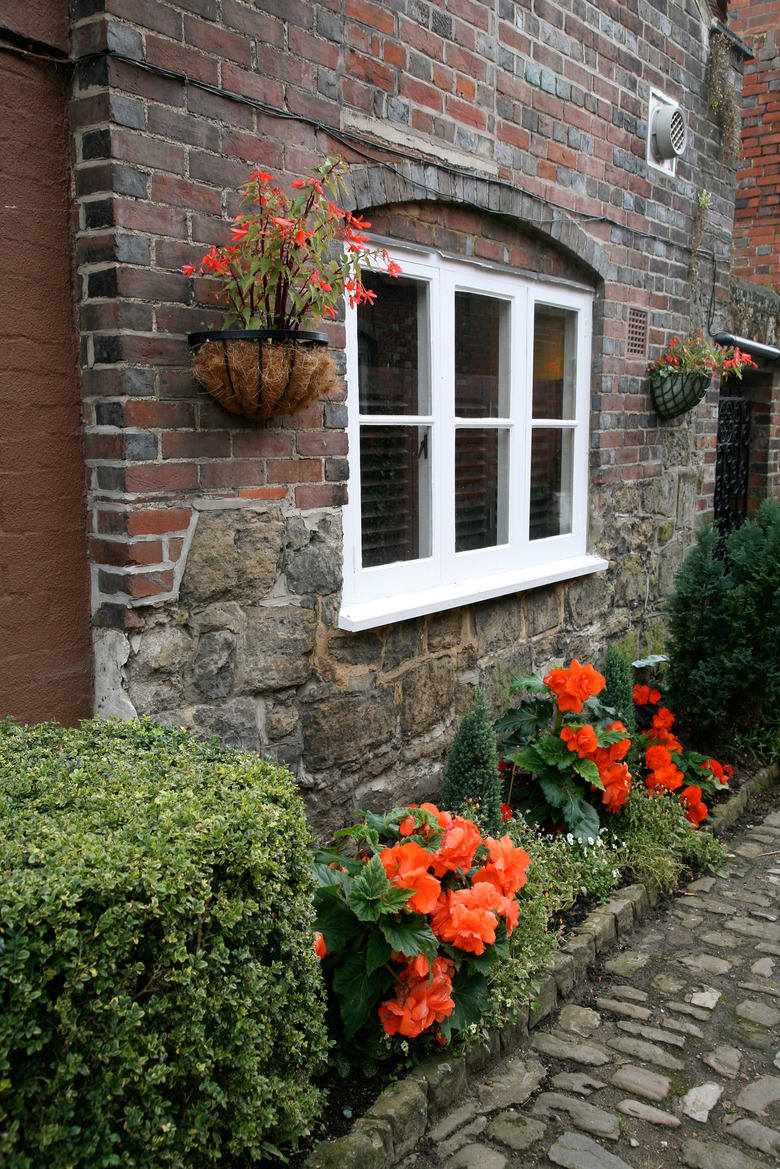What Shrubs Can Be Planted On The West Side Of A House?
The west side of a house is exposed to four to six hours of direct sunlight during the hottest time of day. Shrubs planted there are more likely to thrive if they prefer full-sun to partial-shade exposure. Evergreen, deciduous, needle-leaved and flowering shrubs can be combined to provide a variety of year-round colors and textures.
Deciduous Shrubs
Deciduous Shrubs
Japanese barberries (Berberis thunbergii f. atropurpurea) and Virginia sweetspire (Itea virginica) are deciduous shrubs that can be planted on the west side of a house. Japanese barberries are hardy in U.S. Department of Agriculture plant hardiness zones 4 through 8, although they can be grown in partial shade in USDA zone 9. They are drought-tolerant, deer-resistant and have thorny stems. The "Rose Glow" cultivar (Berberis thunbergii f. atropurpurea "Rose Glow") grows to a height of 3 to 6 feet with rose-pink leaves. "Atropurpurea Nana" (Berberis thunbergii f. atropurpurea "Atropurpurea Nana") grows to a height of 1 1/2 to 2 feet with burgundy leaves.
Virginia sweetspire is hardy in USDA zones 5 through 9 and produces fragrant white flowers in the spring or early summer. It grows to a height of 3 to 5 feet with green leaves that change to red in the fall. The "Henry's Garnet" cultivar (Itea virginica "Henry's Garnet") grows to a height of 3 to 4 feet with garnet-red fall foliage. Virginia sweetspires will grow in clay soil that drains slowly.
Broadleaf Evergreen Shrubs
Broadleaf Evergreen Shrubs
Mahonia (Mohonia trifoliolata) and winterberry or wintergreen barberry (Berberis julianae) are broadleaf evergreen shrubs that can be planted on the west side of a house. Mahonia is hardy in USDA zones 7 through 9 and grows to a height of 2 to 6 feet. It has gray-green, spiny, holly-type leaves and produces yellow, fragrant flowers in early spring and berries that ripen to orange or red. This is a drought-tolerant shrub that grows best where it is protected from strong wind.
Wintergreen barberries are hardy in USDA zones 6 through 9a, bloom in white in the spring and produce small red berries. They grow to a height of 4 to 6 feet with thorny spines and green leaves that change to red in the fall. Wintergreen barberries are only moderately drought-tolerant.
Needle-Leaved Evergreen Shrubs
Needle-Leaved Evergreen Shrubs
Small western red cedar (Thuja plicata) cultivars and shore junipers (Juniperus conferta) are needle-leaf evergreen shrubs that can be planted on the west side of a house. Western or giant red cedar trees, also known as giant arborvitae, grow to about 70 feet tall with scale-type leaves. The "Cuprea" cultivar (Thuja plicata "Cuprea"), however, grows to a height of only 2 to 4 feet, and "Rogersii" (Thuja plicata "Rogersii") matures to 3 feet tall. They are deer-resistant and hardy in USDA zones 5 through 9.
Shore junipers, also known as Japanese shore junipers or Blue Pacifica junipers, grow to a height of 6 inches to 1 1/2 feet and width of 6 to 10 feet. They have soft, gray- or blue-green needle-type leaves and are hardy in USDA zones 5 through 10. These are drought-, air pollution-, deer- and salt-tolerant shrubs that can be planted right on the shoreline.
Flowering shrubs
Flowering shrubs
Red Knock Out roses (Rosa "Radrazz") and "Chickasaw" crape myrtles (Lagerstroemia "Chickasaw") are deciduous flowering shrubs that can be planted on the west side of a house. Knock Out roses are drought-tolerant shrub roses that are highly resistant to common rose diseases. They grow to a height of 3 to 4 feet and are hardy in USDA zones 5 through 9. Their flowers are produced from spring to first frost. "Radrazz" produces single-form red flowers, while "Radtko" (Rosa "Radtko") produces double-form red flowers. There are also pink-, multicolor- and yellow-blooming Knock Out roses. They thrive with as little as three hours of sunlight each day.
"Chickasaw" is a dwarf crape myrtle cultivar that grows to a height of 1 to 2 feet. It is hardy in USDA zones 6 through 9 and blooms in pink-lavender from summer to first frost. They are mildew-resistant and tolerant of air pollution and drought.
References
- Oklahoma State University Cooperative Extension: Ornamentals for Microclimates in Oklahoma
- University of California: Sonoma County Master Gardeners: Berberis
- Floridata: Berberis Thunbergii
- Missouri Botanical Garden: Berberis Thunbergii f. Atropurpurea "Rose Glow"
- Missouri Botanical Garden: Berberis Thunbergii f. Atropurpurea "Atropurpurea Nana"
- Missouri Botanical Garden: Itea Virginica
- Missouri Botanical Garden: Itea Virginica "Henry's Garnet"
- Missouri Botanical Garden: Mahonia Trifoliolata
- University of Florida: IFAS Extension: EDIS: Berberis Julianae Winterberry Barberry
- Floridata: Thuja Plicata
